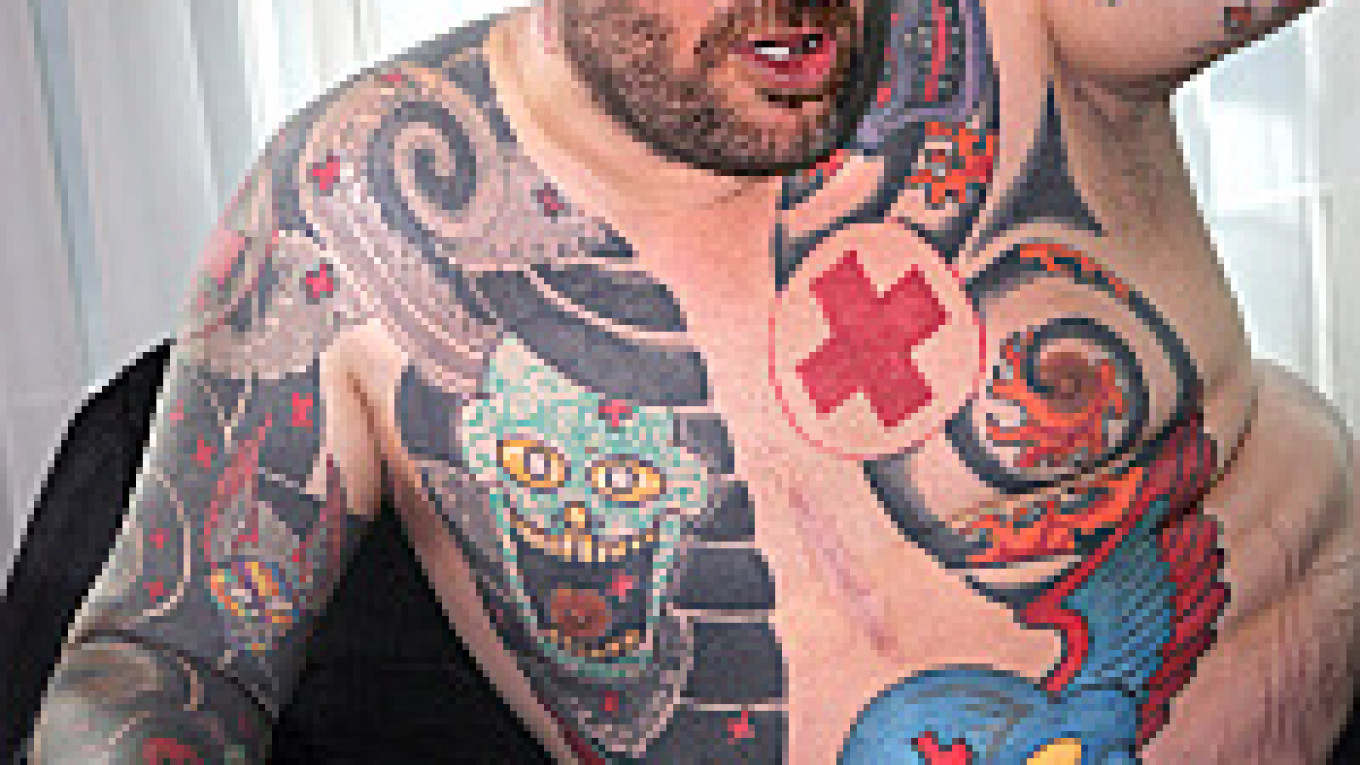Franko has now put all that -- the self-inflicted pain, the horrified or intrigued audiences -- behind him. This week, he brings a show of new sculptures and paintings that refer to traumatic events such as the Beslan massacre to Moscow's RuArts gallery. Accompanying them are graphic photographs and video clips from his performances.
When meeting him in person, it's hard not to stare at Franko, who's talkative and speaks English with a strong Italian accent. He got his first tattoo, of a red cross on his chest, for a performance in 1993. Now his entire body, including his scalp, is decorated with drawings of Tibetan-style laughing skulls, crosses and flames -- a reference to cremation, which is the way he wants to dispose of his body. His bottom teeth jut out, and half of them have been replaced with gold.
He said in an interview Wednesday that his performances have become the subject of exaggerated legends.
"[People say that] I cut myself, which is not true," he complained. "I work with a doctor and it's controlled, you know. That I spray blood on people -- it's not true. That I fainted, that I was carried out after performances, that I get transplants, that I get blood infusions. No. Not true. That I bleed liters. No, I bleed actually very little. If you donated blood you'd probably give more blood than I did in a performance."
Franko was born in Milan in 1960, and lived in a children's home after being abused by his family -- something that he does not talk about in interviews. Moving to London in 1979, he attended art school, and began working with his blood in 1988 after becoming interested in examining things considered disgusting in polite society.
The shows tested the audience as well as Franko's pain threshold, particularly a 2002 performance when individual audience members spent two minutes with a naked, white-painted and bleeding Franko in a small room. One read him poetry. Another urinated.
"To me, it [performing] is about love because it's about giving one's self," Franko explained. "If an artist gives himself or herself totally, then it's about love."
He added: "I did these performances with blood for nearly 15 years, and I felt I'd come to an end of what I could achieve with them and I had to find a new way of bleeding ?€“ a new way to bleed, suffer, without bleeding literally."
All his new pieces are black, and are built up of waxy, lumpen layers of acrylic paint. The centerpiece is a sculpture of Franko holding a skull. One painting was inspired by photographs of prisoners tortured at the hands of U.S. officials at Abu Ghraib prison, in Iraq. Another is a copy of a photograph of a rescuer carrying a boy out of Beslan.
Also hanging in the gallery are pretty portraits of flowers and a deer. "What they represent is that nature gets killed," Franko said. "Bambi gets shot. We eat deer. Flowers die."
"Love in Times of Fear" runs to Nov. 30 at RuArts, located at 10 1st Zachatyevsky Pereulok. Metro Kropotkinskaya. Tel. 201-4475.
A Message from The Moscow Times:
Dear readers,
We are facing unprecedented challenges. Russia's Prosecutor General's Office has designated The Moscow Times as an "undesirable" organization, criminalizing our work and putting our staff at risk of prosecution. This follows our earlier unjust labeling as a "foreign agent."
These actions are direct attempts to silence independent journalism in Russia. The authorities claim our work "discredits the decisions of the Russian leadership." We see things differently: we strive to provide accurate, unbiased reporting on Russia.
We, the journalists of The Moscow Times, refuse to be silenced. But to continue our work, we need your help.
Your support, no matter how small, makes a world of difference. If you can, please support us monthly starting from just $2. It's quick to set up, and every contribution makes a significant impact.
By supporting The Moscow Times, you're defending open, independent journalism in the face of repression. Thank you for standing with us.
Remind me later.


